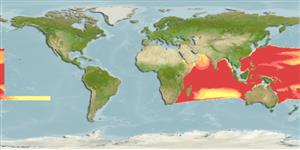Klassifizierung / Names
Namen | Synonyme | Catalog of Fishes(Gattung, Arten) | ITIS | CoL | WoRMS | Cloffa
>
Stomiiformes (Lightfishes and dragonfishes) >
Sternoptychidae (Marine hatchetfishes) > Maurolicinae
Etymology: Argyripnus: Greek, argyros = silver + Greek,hypnos = sleep (Ref. 45335).
Environment: milieu / climate zone / depth range / distribution range
Ökologie
seewasser demersal; tiefenbereich 100 - 492 m (Ref. 75774). Deep-water
Indo-West Pacific. off Africa to the Philippines south to Indonesia and the Coral Sea.
Size / Gewicht / Alter
Maturity: Lm ? range ? - ? cm
Max length : 7.9 cm SL Männchen/unbestimmt; (Ref. 75774)
Kurzbeschreibung
Bestimmungsschlüssel | Morphologie | Morphometrie
Rückenflossenweichstrahlen (insgesamt) : 9 - 12; Wirbelzahl: 42 - 44. Distinguished by the following characters: gill rakers 15-16, usually 16 with typically 12 on the ventral limb; VAV + ACA photophores 13-18, photophore elevation 3.7-6.4% SL; 42-44 total vertebrae, usually 42 or 43; 9-12 dorsal fin rays; no uniquely derived characters known (Ref. 75774).
A mesopelagic species captured near the seafloor by bottom trawl (ref. 75774).
Life cycle and mating behavior
Geschlechtsreife | Fortpflanzung | Ablaichen | Eier | Fecundity | Larven
Harold, A.S. and K. Lancaster, 2003. A new species of the hatchetfish genus Argyripnus (Stomiiformes: Sternoptychidae) from the Indo-Pacific. Proc. Biol. Soc. Wash. 116 (4):883-891. (Ref. 75774)
IUCN Rote Liste Status (Ref. 130435: Version 2024-1)
Bedrohung für Menschen
Harmless
Nutzung durch Menschen
Fischereien: nicht kommerziell
Tools
Zusatzinformationen
Download XML
Internet Quellen
Estimates based on models
Preferred temperature (Ref.
123201): 11.7 - 21, mean 15.6 °C (based on 238 cells).
Phylogenetic diversity index (Ref.
82804): PD
50 = 0.5078 [Uniqueness, from 0.5 = low to 2.0 = high].
Bayesian length-weight: a=0.00468 (0.00194 - 0.01128), b=3.16 (2.95 - 3.37), in cm total length, based on LWR estimates for this (Sub)family-body shape (Ref.
93245).
Trophic level (Ref.
69278): 3.3 ±0.3 se; based on size and trophs of closest relatives
Widerstandsfähigkeit (Ref.
120179): hoch, Verdopplung der Population dauert weniger als 15 Monate. (Preliminary K or Fecundity.).
Fishing Vulnerability (Ref.
59153): Low vulnerability (10 of 100).
